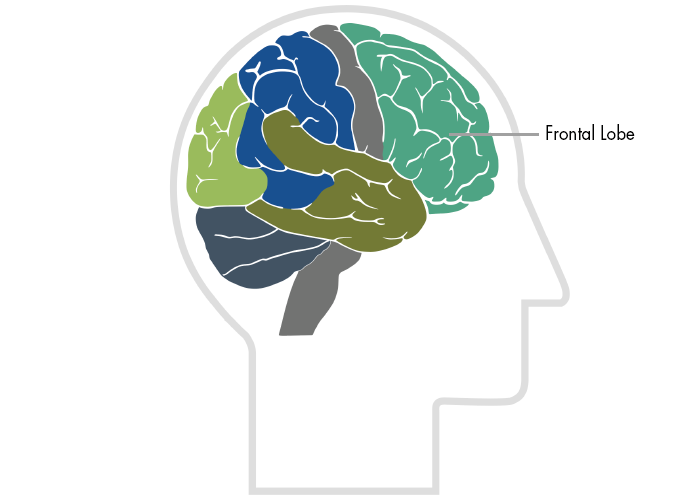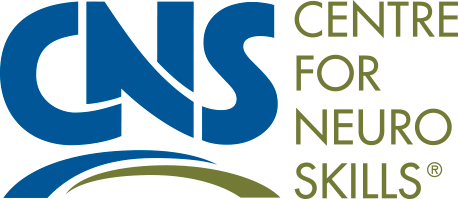Frontal Lobes

The frontal lobes are considered our emotional control center and home to our personality. There is no other part of the brain where lesions can cause such a wide variety of symptoms (Kolb & Wishaw, 1990). The frontal lobes are involved in motor function, problem solving, spontaneity, memory, language, initiation, judgement, impulse control, and social and sexual behavior. The frontal lobes are extremely vulnerable to injury due to their location at the front of the cranium, proximity to the sphenoid wing and their large size. MRI studies have shown that the frontal area is the most common region of injury following mild to moderate traumatic brain injury (Levin et al., 1987).
There are important asymmetrical differences in the frontal lobes. The left frontal lobe is involved in controlling language related movement, whereas the right frontal lobe plays a role in non-verbal abilities. Some researchers emphasize that this rule is not absolute and that with many people, both lobes are involved in nearly all behavior.
Disturbance of motor function is typically characterized by loss of fine movements and strength of the arms, hands and fingers (Kuypers, 1981). Complex chains of motor movement also seem to be controlled by the frontal lobes (Leonard et al., 1988). Patients with frontal lobe damage exhibit little spontaneous facial expression, which points to the role of the frontal lobes in facial expression (Kolb & Milner, 1981). Broca's Aphasia, or difficulty in speaking, has been associated with frontal damage by Brown (1972).
An interesting phenomenon of frontal lobe damage is the insignificant effect it can have on traditional IQ testing. Researchers believe that this may have to do with IQ tests typically assessing convergent rather than divergent thinking. Frontal lobe damage seems to have an impact on divergent thinking, or flexibility and problem solving ability. There is also evidence showing lingering interference with attention and memory even after good recovery from a TBI (Stuss et al., 1985).
Another area often associated with frontal damage is that of "behavioral sponteneity." Kolb & Milner (1981) found that individual with frontal damage displayed fewer spontaneous facial movements, spoke fewer words (left frontal lesions) or excessively (right frontal lesions).
One of the most common characteristics of frontal lobe damage is difficulty in interpreting feedback from the environment. Perseverating on a response (Milner, 1964), risk taking, and non-compliance with rules (Miller, 1985), and impaired associated learning (using external cues to help guide behavior) (Drewe, 1975) are a few examples of this type of deficit.
The frontal lobes are also thought to play a part in our spatial orientation, including our body's orientation in space (Semmes et al., 1963).
One of the most common effects of frontal damage can be a dramatic change in social behavior. A person's personality can undergo significant changes after an injury to the frontal lobes, especially when both lobes are involved. There are some differences in the left versus right frontal lobes in this area. Left frontal damage usually manifests as pseudodepression and right frontal damage as pseudopsychopathic (Blumer and Benson, 1975).
Sexual behavior can also be effected by frontal lesions. Orbital frontal damage can introduce abnormal sexual behavior, while dorolateral lesions may reduce sexual interest (Walker and Blummer, 1975).
Some common tests for frontal lobe function are: Wisconsin Card Sorting (response inhibition); Finger Tapping (motor skills); Token Test (language skills).
References:
Blumer, D., & Benson, D. Personality changes with frontal and temporal lobe lesions. In D. Benson and D. Blumer, eds. Psychiatric Aspects of Neurologic Disease. New York: Grune & Stratton, 1975.
Brown, J. Aphasia, Apraxia and Agnosia. Springfield, IL: Charles C. Thomas, 1972.
Drewe, E. (1975). Go-no-go learning after frontal lobe lesion in humans. Cortex, 11:8-16.
Kolb, B., & Milner, B. (1981). Performance of complex arm and facial movements after focal brain lesions. Neuropsychologia, 19:505-514.
Kuypers, H. Anatomy of the descending pathways. In V. Brooks, ed. The Nervous System, Handbook of Physiology, vol. 2. Baltimore: Williams and Wilkins, 1981.
Leonard, G., Jones, L., & Milner, B. (1988). Residual impairment in handgrip strength after unilateral frontal-lobe lesions. Neuropsychologia, 26:555-564.
Levin et al. (1987). Magnetic resonance imaging and computerized tomography in relation to the neurobehavioral sequelae of mild and moderate head injuries. Journal of Neurosurgery, 66, 706-713.
Miller, L. (1985). Cognitive risk taking after frontal or temporal lobectomy. I. The synthesis of fragmented visual information. Neuropsychologia, 23:359-369.
Milner, B. Some effects of frontal lobectomy in man. In J. Warren and K. Akert, eds. The Frontal Granular Cortex and Behavior. New York: McGraw-Hill, 1964.
Semmes, J., Weinstein, S., Ghent, L., & Teuber, H. (1963). Impaired orientation in personal and extrapersonal space. Brain, 86:747-772.
Stuss, D. et al. (1985). Subtle neuropsychological deficits in patients with good recovery after closed head injury. Neurosurgery, 17, 41-47.
Walker, E., & Blumer, D. The localization of sex in the brain. In K.J. Zulch, O. Creutzfeldt, and G. Galbraith, eds. Cerebral Localization, Berlin and New York: Springer-Verlag, 1975.

